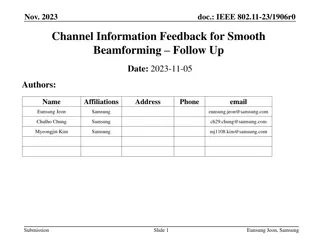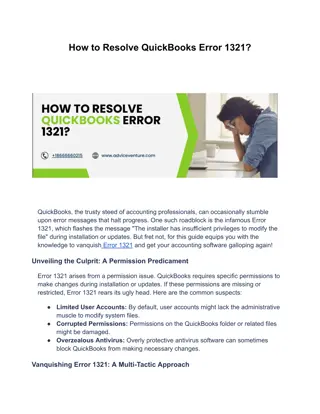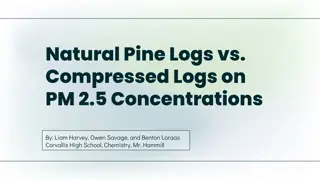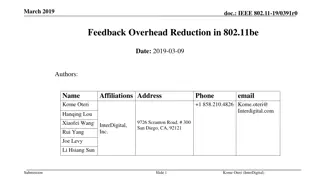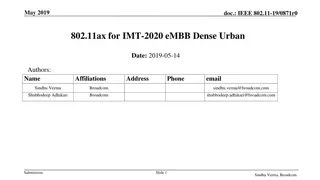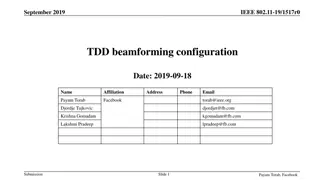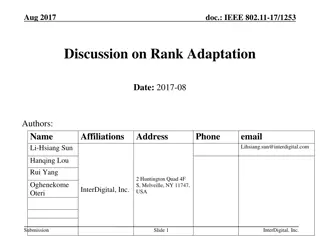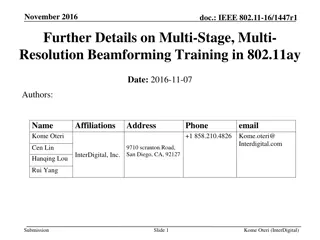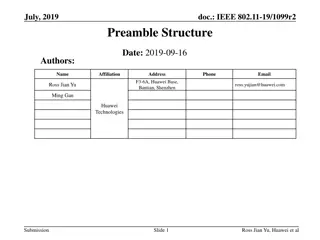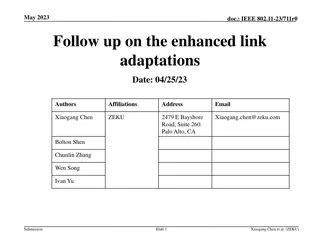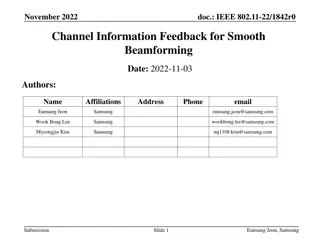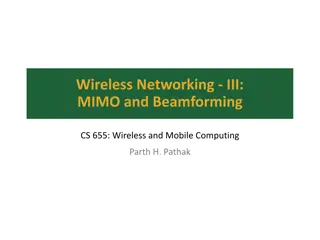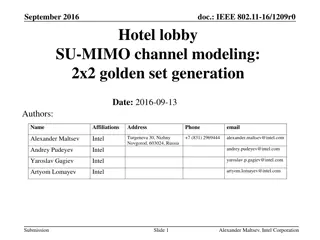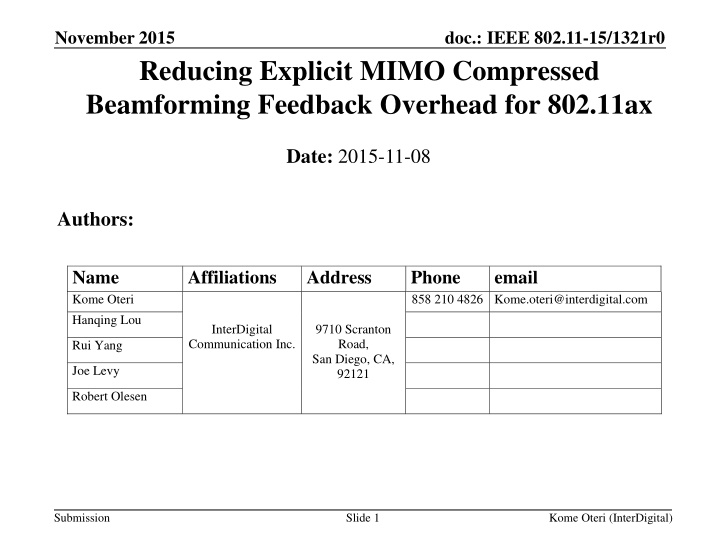
Reducing Explicit MIMO Compressed Beamforming Overhead for 802.11ax
In this document from November 2015, the authors discuss methods to reduce explicit MIMO compressed beamforming feedback overhead in 802.11ax. They explore extension and new schemes to minimize feedback overhead for improved efficiency in wireless communication systems.
Download Presentation

Please find below an Image/Link to download the presentation.
The content on the website is provided AS IS for your information and personal use only. It may not be sold, licensed, or shared on other websites without obtaining consent from the author. If you encounter any issues during the download, it is possible that the publisher has removed the file from their server.
You are allowed to download the files provided on this website for personal or commercial use, subject to the condition that they are used lawfully. All files are the property of their respective owners.
The content on the website is provided AS IS for your information and personal use only. It may not be sold, licensed, or shared on other websites without obtaining consent from the author.
E N D
Presentation Transcript
November 2015 doc.: IEEE 802.11-15/1321r0 Reducing Explicit MIMO Compressed Beamforming Feedback Overhead for 802.11ax Date: 2015-11-08 Authors: Name Kome Oteri Hanqing Lou Affiliations InterDigital Communication Inc. Address 9710 Scranton Road, San Diego, CA, 92121 Phone 858 210 4826 Kome.oteri@interdigital.com email Rui Yang Joe Levy Robert Olesen Submission Slide 1 Kome Oteri (InterDigital)
November 2015 doc.: IEEE 802.11-15/1321r0 Outline Introduction Extension Schemes New Schemes Conclusion Submission Slide 2 Kome Oteri (InterDigital)
November 2015 doc.: IEEE 802.11-15/1321r0 Introduction In this contribution, we discuss possible methods to reduce explicit MIMO compressed beamforming feedback overhead in 802.11ax. 802.11ac supports explicit MIMO compressed beamforming feedback with (4,2) or (6,4) bits to quantize angle ( , ) for single user, and (7,5) or (9,7) bits to quantize angle ( , ) for multi-user. For 802.11ax, the following has been agreed to [1]: The amendment shall define a mechanism to reduce the MIMO compressed beamforming feedback overhead. [MU Motion 25, September 17, 2015, see [2]] We discuss two groups of schemes: Extension Schemes: Extension of 802.11ac feedback schemes. We discuss six schemes. New Schemes: New (to 802.11) MIMO compressed beamforming feedback schemes. We discuss two schemes. Our goal is to narrow down possible schemes for further study and design. Submission Slide 3 Kome Oteri (InterDigital)
November 2015 doc.: IEEE 802.11-15/1321r0 Extension Schemes Extending the current beamforming feedback may be done by 1. Large Ng: Increase the tone grouping size {Ng} during feedback [3][4] 2. Only Feedback: Feedback only in N x 1 transmission and assume a fixed [5] 3. Variable Angle Quantization: Use different quantization levels for different Given s rotation angles ( i, i). 4. Differential Given s Rotation: Feedback time or frequency difference in Given s Rotation angles. 5. Multi-resolution/Multi-stage feedback Identify frequency band(s)/Resource Units (RU(s)) based on scalar feedback (e.g. SNR) and feed back full CSI for desired frequency band /RU(s). 6. Time Domain Channel Feedback Feed back time domain channel Submission Slide 4 Kome Oteri (InterDigital)
November 2015 doc.: IEEE 802.11-15/1321r0 Extension Scheme (1) 1. Large Ng: Increase the tone grouping size {Ng} during feedback Minimum size has already been increased to 2 [3] Maximum size may be increased to 16 with little impact on performance for some scenarios [4] Submission Slide 5 Kome Oteri (InterDigital)
November 2015 doc.: IEEE 802.11-15/1321r0 Extension Scheme (2) 2. Only Feedback: Feed back only in N x 1 transmission and assume a fixed [5] 802.11ah supports feedback of ? angles only with single data stream transmissions. The values of are fixed [5, 24.3.10.2] Reduction in overhead is shown in the tables below (methodology in appendix) We may keep the overhead the same and increase b . (Table 1 and 2) We may reduce the overhead by keeping b the same and changing b (Table 1 and 3) Submission Slide 6 Kome Oteri (InterDigital)
November 2015 doc.: IEEE 802.11-15/1321r0 Extension Schemes (3) 3. Variable Angle Quantization : Use different quantization levels for different Given s rotation angles ( i, i). Angle may vary over the distribution; for example range of 1is greater than range of 7 for 8 x 1 system shown below. To quantize the angles after Givens rotation, we may use different ranges for different angles or groups of angles. For each angle or groups of angles, the range = ?,? 0,2? . Kome Oteri (InterDigital) Submission Slide 7
November 2015 doc.: IEEE 802.11-15/1321r0 Extension Schemes (4) 4. Differential Given s Rotation : Feed back time or frequency difference in Given s Rotation angles Send differential information between Given s rotation angles of baseline channel and next channel in time [6] or frequency May use scalar difference (subtraction) or vector difference (range/null space overlap). H(k) {f(k), y(k)} Givens decomp. Original quantization - H(k+4) {df, dy} {f(k+4), y(k+4)} Givens decomp. Differential quantization + Empirical CDF Empirical CDF 1 1 Channel B+D+E Channel B only 0.9 0.9 0.8 0.8 0.7 0.7 0.6 0.6 F(x) F(x) 0.5 0.5 0.4 0.4 Channel B+D+E Channel B only 0.3 0.3 0.2 0.2 0.1 0.1 0 0 -0.5 -0.4 -0.3 -0.2 -0.1 0 0.1 0.2 0.3 0.4 0.5 -1 -0.8 -0.6 -0.4 -0.2 0 0.2 0.4 0.6 0.8 1 radians radians ?? is approximately distributed within the range of ?/2,?/2 ?? 0,2? ?? is approximately distributed within the range of ?/8,?/8 vs 0,?/2 Kome Oteri (InterDigital) Submission Slide 8
November 2015 doc.: IEEE 802.11-15/1321r0 Extension Schemes (5) 5. Multi-Resolution/Multi-Stage Feedback : Identify desired band/RU based on scalar feedback (e.g. SNR) then feed back full CSI for specific RU(s). This is an example of a scheme enabling a feedback granularity of less than 20 MHz [1] The table below shows total feedback per transmission per user, i.e. the amount of feedback needed from a user to enable a successful transmission: Can save 90% overhead per user per Total Feedback /user /transmission SNR Total Feedback (Typical RU) Total Feedback (DC RU) Typical RUs DC RU Total RUs Feedback Typical RU Feedback DC RU Feedback (2 bytes) Total Feedback Overhead Savings (%) SU, 8x4, 26 tone RU (Bytes) SU, 8x4, 242 tone RU (Bytes) 8 1 9 202 202 18 1616 202 1836 204.00 87.73% 1 0 1 1660 202 2 1660 0 1662 1662.00 N/A Overhead savings is compared with 242 tone RU case Total Feedback/Tx/User = 2 bytes* No. RUs + No. subcarrier per RU * VHT BF report (bytes) Additional details in Appendix Submission Slide 9 Kome Oteri (InterDigital)
November 2015 doc.: IEEE 802.11-15/1321r0 Extension Schemes (6) 6. Time domain channel feedback: Feed back time domain channel Number of significant taps may be much less than the number of tones and may result in feedback overhead savings. However, may need to feed back U, S and V of time domain channel U to enable transformation of the channel to the frequency domain. i.e. one additional matrix. May also need to indicate position of tap As such, there may be a trade-off between increasing the feedback per tap and the number of taps fed back. Submission Slide 10 Kome Oteri (InterDigital)
November 2015 doc.: IEEE 802.11-15/1321r0 New Feedback Schemes 7. Multiple component feedback: splits feedback into multiple components [7] One component has a larger size and is fed back at longer intervals. One component is smaller and is sent back at shorter intervals. The combination of both may reduce the overall feedback Examples include Feed back long term / short term information Feed back wideband / sub-band information Codebook-based feedback: Feed back codeword from a well designed codebook [8] Overall feedback may reduce based on the size of the codebook. 8. Submission Slide 11 Kome Oteri (InterDigital)
November 2015 doc.: IEEE 802.11-15/1321r0 Summary (Pros and Cons) Submission Slide 12 Kome Oteri (InterDigital)
November 2015 doc.: IEEE 802.11-15/1321r0 Conclusions Multiple schemes may be used to reduce the explicit MIMO compressed beamforming Feedback Overhead for 802.11ax They include six schemes that are simple extensions of 802.11ac feedback schemes. They include two new (to 802.11) MIMO compressed beamforming feedback schemes. The performance of these methods should be studied and a combination of them adopted in 802.11ax Submission Slide 13 Kome Oteri (InterDigital)
November 2015 doc.: IEEE 802.11-15/1321r0 References 1. 2. 3. 4. 5. 6. 11-15-0132-09-00ax-spec-framework 11-15-1129-01-00ax-feedback-overhead-in-dl-mu-mimo 11-15-1071-02-00ax-tone-grouping-factors-and-ndp-format-for-802-11ax 11-15-1320-00-00ax-Maximum-tone-grouping-for-802_11ax-feedback IEEE P802.11ah /D2.0 Amendment 6: Sub 1 GHz License Exempt Operation Porat, R.; Ojard, E.; Jindal, N.; Fischer, M.; Erceg, V., "Improved MU-MIMO performance for future 802.11 systems using differential feedback," in Information Theory and Applications Workshop (ITA), 2013 , vol., no., pp.1-5, 10-15 Feb. 2013 Chaiman Lim; Taesang Yoo; Clerckx, B.; Byungju Lee; Byonghyo Shim, "Recent trend of multiuser MIMO in LTE-advanced," in Communications Magazine, IEEE , vol.51, no.3, pp.127-135, March 2013 Love, D.J.; Heath, R.W.; Lau, V.K.N.; Gesbert, D.; Rao, B.D.; Andrews, M., "An overview of limited feedback in wireless communication systems," in Selected Areas in Communications, IEEE Journal on , vol.26, no.8, pp.1341-1365, October 2008. 7. 8. Submission Slide 14 Kome Oteri (InterDigital)
November 2015 doc.: IEEE 802.11-15/1321r0 Straw Poll #1 Do you agree to add the following to section 4.6 of the SFD ? The amendment may consider methods that extend the compressed beamforming feedback ideas in 802.11ac Y/ N/ A Submission Slide 15 Kome Oteri (InterDigital)
November 2015 doc.: IEEE 802.11-15/1321r0 Straw Poll #2 Do you agree to add the following to section 4.6 of the SFD ? The amendment may consider new ideas that are different from the compressed beamforming feedback ideas in 802.11ac Y/ N/ A Submission Slide 16 Kome Oteri (InterDigital)
November 2015 doc.: IEEE 802.11-15/1321r0 Additional Material Submission Slide 17 Kome Oteri (InterDigital)
November 2015 doc.: IEEE 802.11-15/1321r0 Multi-Resolution/Multi-Stage Feedback Overhead Total Feedback /user /transmission SNR Total Feedback (Typical RU) Total Feedback (DC RU) Typical RUs DC RU Total RUs Feedback Typical RU Feedback DC RU Feedback (2 bytes) Total Feedback Overhead Savings (%) SU, 2x1, 26 tone RU (Bytes) SU, 4x1, 26 tone RU (Bytes) SU, 8x1, 26 tone RU (Bytes) SU, 8x2, 26 tone RU (Bytes) SU, 8x4, 26 tone RU (Bytes) 8 1 9 42 42 18 336 42 396 44.00 60.00% 8 1 9 57 57 18 456 57 531 59.00 77.13% 8 1 9 87 87 18 696 87 801 89.00 83.91% 8 1 9 129 129 18 1032 129 1179 131.00 86.34% 8 1 9 202 202 18 1616 202 1836 204.00 87.73% SU, 2x1, 52 tone RU (Bytes) SU, 4x1, 52 tone RU (Bytes) SU, 8x1, 52 tone RU (Bytes) SU, 8x2, 52 tone RU (Bytes) SU, 8x4, 52 tone RU (Bytes) 4 1 5 49 42 10 196 42 248 49.60 54.91% 4 1 5 79 57 10 316 57 383 76.60 70.31% 4 1 5 139 87 10 556 87 653 130.60 76.38% 4 1 5 223 129 10 892 129 1031 206.20 78.50% 4 1 5 367 202 10 1468 202 1680 336.00 79.78% SU, 2x1, 106 tone RU (Bytes) SU, 4x1, 106 tone RU (Bytes) SU, 8x1, 106 tone RU (Bytes) SU, 8x2, 106 tone RU (Bytes) SU, 8x4, 106 tone RU (Bytes) 2 1 3 67 42 6 134 42 182 60.67 44.85% 2 1 3 132 57 6 264 57 327 109.00 57.75% 2 1 3 262 87 6 524 87 617 205.67 62.81% 2 1 3 442 129 6 884 129 1019 339.67 64.58% 2 1 3 752 202 6 1504 202 1712 570.67 65.66% SU, 2x1, 242 tone RU (Bytes) SU, 4x1, 242 tone RU (Bytes) SU, 8x1, 242 tone RU (Bytes) SU, 8x2, 242 tone RU (Bytes) SU, 8x4, 242 tone RU (Bytes) 1 0 1 108 42 2 108 0 110 110.00 N/A 1 0 1 256 57 2 256 0 258 258.00 N/A 1 0 1 551 87 2 551 0 553 553.00 N/A 1 0 1 957 129 2 957 0 959 959.00 N/A 1 0 1 1660 202 2 1660 0 1662 1662.00 N/A Overhead savings is compared with 242 tone RU case Total Feedback/Tx/User = 2 bytes* No. RUs + No. subcarrier per RU * VHT BF report (bytes) Submission Slide 18 Kome Oteri (InterDigital)
November 2015 doc.: IEEE 802.11-15/1321r0 Overhead Calculation Details VHT Compressed Beamforming frame is utilized for CSI feedback. Frame Size = MAC Header size + VHT Compressed BF frame Action field size VHT Compressed Beamforming frame action field format VHT Compressed BF Report Average SNR per stream Angles {?,?} compressed from V matrices per Ng subcarriers Number of angles reported depend on the size of V matrices. Number of bits for ? and ?, ?? and ??, are determined by VHT MIMO Control field. Submission Slide 19 Kome Oteri (InterDigital)


